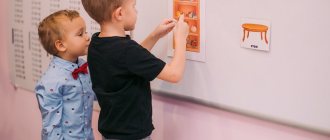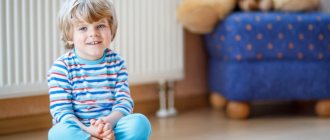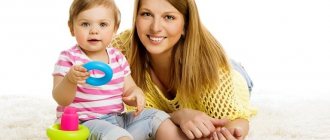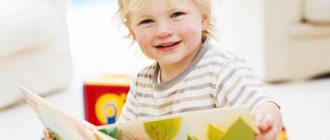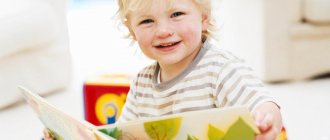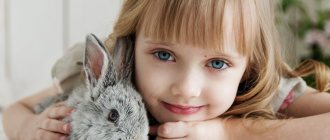The development of a child at 3 years old is actively manifested in all aspects of his activities. These are physical criteria, and mental, and mental, and emotional. Compared to previous years, three-year-old children can already do a lot, reach certain heights, and become more independent. There are many obstacles along the way, one of which is the “three-year-old crisis.” What is it, and how does it manifest itself? Our article will help you understand this and other development issues.
Features of development of children 3 years old
Three years is an important age in the life of a baby. At this time, great changes occur in his psyche. A calm, obedient child suddenly becomes capricious and uncontrollable, and the parents are perplexed: what happened?
There's no need to worry. In psychology, there is such a thing as the three-year crisis. It is he who provokes such changes in the behavior of children. The first signs of an emerging crisis become noticeable as early as two years of age. By the end of the third year of life, the crisis reaches its peak.
The crisis of three years can be recognized by the following signs:
- Negativism. The child refuses all requests and suggestions from the parents. This greatly irritates adults, but you need to understand that in this way the baby learns to recognize himself as a separate person.
- Stubbornness. The baby becomes very stubborn. He demands that his wishes be fulfilled immediately, and if this does not happen, he throws a tantrum.
- The desire for independence. The child tries to do everything himself - dress, wash, brush his teeth, etc. Adults’ attempts to help him are categorically rejected.
- Conflict. The child becomes conflicted: he contradicts his parents, swears, ignores their requests, and protests against the established rules.
- Jealousy. The baby begins to be jealous of his parents for his brothers or sisters. If there are none, he may begin to be jealous of mom and dad.
These changes in behavior are age-related features that go away over time.
What might be a cause for concern?
Of course, it is not necessary for a three-year-old child to have all of the listed skills - he may not know or be able to do some things, but this is acceptable by developmental standards. However, these signs should alert adults:
- the child speaks indistinctly and incomprehensibly, swallows words or their endings, mumbles;
- the baby experiences increased salivation;
- the baby cannot dress himself, cannot hold a spoon and relieve himself without outside help;
- the baby does not know how to throw a ball, jump, and walks poorly;
- a simple logical chain is incomprehensible to a child, he does not know the basic concepts, he does not know how to build a tower from cubes;
- the baby is afraid of new acquaintances, does not make contact with other children, and constantly needs the presence of his parents;
- hysterical for any reason, does not recognize relatives, does not make eye contact;
- The baby is irritable and anxious.
Such signs may indicate insufficient development of the child. A more precise formulation of the baby’s condition will be given by the doctor who will need to show him, and it is recommended to do this immediately. After counseling and some therapy, your child will begin to develop like other children. Well, if your baby is simply lazy to perform some actions, then over time this laziness will pass, and the baby’s normal development will be restored.
Comments ()
Intellectual development
At this age, visual-effective thinking is transformed into visual-figurative thinking. If previously the baby learned about the world through direct contact with various objects, now he can already operate with images of these objects stored in his memory.
At three years old, a child should be able to:
- understand simple cause-and-effect relationships;
- demonstrate first action planning skills;
- compare objects by size, shape, color;
- put together simple puzzles from four large parts;
- know the basic colors and be able to name them;
- know the names of surrounding objects (dishes, furniture, products), animals;
- know the names of basic geometric shapes.
An important feature of this age is that a growing baby can think and reason about objects that are not in the field of view. This is an important step towards further development of thinking.
Speech development
All parents dream of seeing their child successful in the future! They try to give him the necessary knowledge and skills, and enroll him in various clubs to acquire skills. Along with physical and intellectual improvement, it is necessary to pay attention to speech development. After all, in any contact with the outside world, a person needs speech, and the better he knows the verbal (through oral speech) method of communication, the simpler and better the process of his communication in society will be.
Speech develops from birth, and the task of adults is to provide the correct speech environment for the baby. It is necessary to constantly talk to the child, without distorting the sound content of words, and not choose long sentences. But, most importantly, talk a lot, not loudly, slightly at a slow pace, so that the child accumulates a vocabulary of words that he can later put into phrases and sentences.
At three years old, the speech of a normotypical child is sufficiently developed; the baby has problems with the pronunciation of sounds, but this is a minor problem for this age.
Please note:
- whether the child correctly understands the speech of an adult addressed to him, whether he can carry out complex instructions;
- how are articulation skills developed, is there any hypersalivation (salivation), can the baby perform simple articulatory movements;
- how the baby develops coherent speech (composing detailed sentences, answering a question in more than one word);
- does he correctly coordinate words in phrases and phrases (for example: “blue sky”, “delicious jam”...);
- is he able to change and form the forms of words (ear - ear, pear - no pears, raspberry jam - raspberry, maple leaf - maple).
Here are examples of some games that promote speech development:
"Young Journalist"
We invite the child to work as a reporter (having previously explained what this means) and write a report about some toy. Tell what kind of toy it is, what material it is made of, what color and shape.
"In the gnome's cave"
We explain that the gnome has everything small, unlike the giant, and if the giant has a “chair”, then the gnome has a “chair” and select any other words.
"The Tale of the Merry Tongue"
Exercises for the development of articulatory motor skills. The fairy tale uses words that denote articulation exercises: “needle”, “cup”, “horse”, “motor”, “delicious jam”, “boat”, “fence”, “window”, “fungus”.
You can come up with your own fairy tale, for example: “Once upon a time there was a tongue!” He woke up in the morning, looked out of the “window” and went for a walk. On the way I saw a “horse” and a “fungus”...
Descriptions of the exercises can be found widely available on any Internet resource dedicated to speech therapy development.
The development of articulation prepares the child to pronounce difficult sounds and words, develops various pronunciation abilities, and eliminates hypersalivation. If you do articulation exercises from an early age, you are more likely to have all the sounds fall into place at the right time.
"Tell me what you hear"
Development of phonemic hearing (distinguishing speech and non-speech sounds).
The child is asked to say what sound he heard. You can use a screen so that the child guesses only by sound, without visual confirmation. For example, the sound of a bell, rustling paper, or the sounds of animals.
Phonemic hearing plays a big role in correct sound pronunciation and learning elements of literacy at an older age.
Speech development
The speech of a three-year-old is very different from the speech of a two-year-old baby. At this age, the child already has a fairly large vocabulary - from 1000 words. The baby can reason and make simple conclusions about people, objects and phenomena.
Children actively remember new words, play with them (change pronunciation, rhyme, come up with sound combinations). Long, complex words are still difficult for babies to pronounce, so they mutilate them.
A 3 year old child should be able to:
- tell how his day went;
- use sentences of 3–5 words or more in speech;
- describe the picture;
- memorize poems and songs;
- name not only the object itself, but also its details (handle of a cup, nose of a dog);
- establish semantic connections between objects;
- ask and answer questions;
- Use polite words (“thank you”, “please”).
Three-year-olds do not yet have very well developed speech. They pronounce hissing and sonorant sounds poorly. They construct sentences incorrectly and lose the endings of words. All this is the norm of development. With age, problems will be eliminated.
Meaning of Parental Restriction
A ban is a boundary for a child set by parents for his benefit. It has an important educational function—it forms the perception of reality in the child’s mind. The little one learns to understand when to stop being capricious and how to behave with other people.
Of course, children are not happy with parental prohibitions and may become angry and offended, but adults need to understand that these boundaries play an important psychological role in the proper upbringing of a child. Thanks to them, boys and girls aged 3 feel parental care, calm down and begin to get used to discipline.
Unfortunately, in our time there is a pressing problem when parents, who “grew up” on numerous prohibitions, allow their child a lot. With age, the child will develop a serious dependence on manipulation and provocation, immaturity, and capriciousness.
The second, very serious parental mistake is the abuse of prohibitions. The result of such upbringing: a timid, timid and indecisive person who will consult with his parents before making a decision.
In order not to encounter the above problems, parents need to justify the ban. It is important for the toddler to understand why certain actions are prohibited.
Based on the root causes, prohibitions can be conscious or unconscious.
Conscious prohibition
Involves parental protection of the child from unpleasant phenomena. For example, by not allowing the baby to eat ice cream or drink cold juice, the mother will protect the baby from a sore throat.
This also includes prohibitions that help develop the concept of discipline in a child. If they are not used, there is a risk that whims, tantrums and the desire to manipulate will become habitual phenomena for the child.
Another reason for a conscious prohibition is habit. The child’s parents unwittingly copy the educational methods of their parents and forbid their children the same things that were forbidden to them in childhood.
Unconscious prohibition
Adults resort to unconscious prohibitions for the following reasons:
- Underneath them lies worry, resentment, and irritation.
- Envy. Without allowing something, a parent can involuntarily remember his childhood years and compare it with the life of his baby. A shortage of beautiful toys and clothes can provoke envy, which will result in an unconscious ban. This ban does not have a protective, educational function.
- Anxiety. Excessive parental care can often harm a toddler. For example, he wants to get a cat or a dog. By taking care of a pet, he will understand what responsibility, duty, and discipline are. But parents may think that the pet might bite the child. As a result, the baby is refused.
To summarize, we can say that parents should not:
- use a judgmental tone;
- prohibit your favorite activity;
- abuse prohibitions.
Neuropsychic development
During this period, the performance of the nervous system increases. The baby can already restrain his emotions, for example, not cry when he is hurt or offended.
His ability to concentrate increases. Now he can do something for 10–15 minutes without being distracted by anything else. Distracting a crying three-year-old by redirecting his attention is not so easy, because he has already concentrated on his negative emotions.
At this age, the child cannot yet properly manage his behavior. The three-year crisis mentioned above also adds to the difficulties. The baby's inner world is full of contradictions that result in whims and hysterics.
Baby's temperament
It's no secret that kids have different attitudes towards prohibitions: some are calm, some play around, and some become simply uncontrollable. Psychologists have proven that there is no point in using the same approach, since each child has his own temperament. Considering this, you can find a common language even with a problem child.
If you ignore his temperament when raising a child, this can cause not only disobedience and numerous problems, but also complete personality degradation.
It has been proven that if in childhood a person often suffered from curses and beatings, he is more prone to alcoholism and drugs. It is difficult for such people to communicate with peers.
At 3-4 years old, a child’s temperament begins to manifest and his behavior is formed. Psychologists remind us of the importance of distinguishing between the concepts of “temperament” and “character”. The first is the type of nervous system given by nature, the second is upbringing, with the help of which you can compensate for the disadvantages of temperament.
There are four types of temperament. Let's look at each type in more detail.
Sanguine
It is not difficult to raise such a child, since he is always in a good mood. Typical signs of a sanguine person:
- no mood swings;
- mobility, desire to communicate;
- good nervous system, high self-esteem;
- good sleep, quick awakening.
Sanguine people are cunning - they will never do what they don’t like. Parents need to be careful not to unconditionally believe everything the child says.
To teach a sanguine person order and discipline, parents need to explain to him in a calm tone, without shouting. It is also not recommended to overpraise a sanguine person, as this can provoke “star fever”.
Melancholic
He is in dire need of attention. Children with this temperament are sensitive, easily upset, and offended. For them, the scream of an adult is tantamount to physical punishment. Melancholic people are endowed with:
- sensitivity;
- rapid fatigue;
- difficult adaptation to new conditions.
Parents of a melancholic person should not punish him for slowness or shame him in front of others.
Phlegmatic person
This child is different:
- lack of emotion;
- slowness;
- ability to sleep more than 9 hours.
Based on this characteristic, parents are not recommended to verbally explain the requirements to the child or passively spend time with him. To prevent the baby from growing up inert in the future, he needs to be involved in active games and shown by example how to behave.
Choleric
A child with such a temperament is a perpetual motion machine. He needs to be constantly on the move, but he rarely completes anything.
Choleric stands out from others:
- emotionality;
- mobility and noise;
- disturbing dream.
If you do not deal with a choleric person, he will develop into an overly emotional, aggressive and antisocial personality. In order for him to begin to obey, you cannot be aggressive and overprotective with him. If a choleric person begins to cry or scream, parents need to speak in a calm tone. The main task of adults is to be balanced in conflicts with a child.
Each toddler mixes 2 temperaments. It depends on upbringing which type will be dominant.
Math skills
At 3 years old, children already have some mathematical skills. They must know and be able to:
- count to five forward and backward;
- show the number on your fingers;
- know what numbers from 1 to 5 look like;
- compare the number of objects in different groups using the concepts “more”, “less”, “same”;
- know and be able to draw basic geometric shapes (circle, square, triangle, oval, rectangle);
- recognize the outlines of geometric shapes in various objects (a clock is a circle, a TV is a rectangle).
Some kids already know all the numbers from 0 to 10 and can write them. This is a good help for future preparation for school.
Physical development
A 3-year-old child controls his body much more confidently than a 2-year-old. At this age, children can:
- jump on two legs in height and length;
- stand on one leg without falling;
- jump over obstacles;
- run quickly and confidently;
- climb the wall bars;
- ride a tricycle or scooter;
- ride downhill;
- kick the ball.
Kids love physical activity and quickly develop their abilities.
Development of a child's physical abilities
This type is aimed at developing the child’s coordination of movements, developing manual dexterity, and increasing qualities such as endurance.
Classes for physical development must be carried out every day and include the following types of exercises:
- doing exercises accompanied by music;
- stepping over laid out bars or other obstacles;
- teaching a child to walk on an inclined board;
- jumping in place and to music on two legs and on one;
- jumping from small obstacles;
- playing games with simple rules;
- if there is a wall bars at home, this also contributes to a more active pastime.
Logical thinking
At 3 years old, children already have some logical thinking skills. They must be able to:
- combine two objects into a logical pair (“pencil-paper”, “tea-cup”);
- exclude unnecessary items from a group;
- understand the logical sequence of events (clouds gathered in the sky - it began to rain - the ground became wet);
- highlight the main properties of objects and combine them into groups according to these properties;
- understand time sequence (“yesterday”, “today”, “tomorrow”, “now”, “later”);
- distinguish opposites (big - small);
- understand the location of objects in space (“above”, “below”, “above”, “below”).
Self-care skills
Children at 3 years old can already do a lot on their own, without the help of their elders. For example:
- dress, undress, fasten and unfasten zippers and large buttons;
- putting on shoes (it’s normal if the baby puts shoes on the wrong foot);
- confidently wield a spoon and fork, drink from a cup, wipe your mouth with a napkin;
- wash your face, wash your hands, brush your teeth;
- put toys back in place;
- carry out small household tasks (lay out cutlery on the table, pour food into the cat’s bowl).
The less parents try to help the baby, the faster he develops everyday skills.
Difficulties of parenting
Parents are often shocked by changes with their baby. His taste begins to change; previously favorite games become annoying. A child can argue with adults and act out of spite. It often happens that a child wants to do something, but does not do it. More often than not, tantrums appear on display.
Surely each of us has seen how a child begins to cry a lot and stamp his feet in a public place, demanding that his desire be satisfied. This situation is aggravated by the judgmental words of others. As a result, mom/dad has to fulfill the baby’s whim. If no measures are taken, the child will manipulate adults at every opportunity.
But you also need to be extremely careful with severity. Parents should not “block” any natural manifestation of the baby with their screams. If you constantly yell at your child, he will stop wanting to do anything and decide that it is best to be calm and sit still. If he does not feel parental love, he will become accustomed to learned helplessness.
Studying the psychological characteristics of children aged 3-4 years, psychologists came to the conclusion that the combination of a strict mother and a kind father has a negative impact on the child. The baby begins to take the side that is convenient for him at a certain moment.
Some parents consider it quite normal to drag their child into a marital quarrel and force them to take the side of one of the parents. In order not to lose loved ones, the toddler can choose 2 behavior models:
- Tries to be good and obedient, experiencing constant anxiety.
- He indulges himself on purpose so that his loved ones will rally around him.
Divorce of parents has an extremely negative impact on the psychology of children 4–5 years old. If he sees that there is no love between his parents and they live together for his sake, the child begins to suffer from an unconscious, deep sense of guilt. It is important for parents to understand that children of this age understand more than adults think.
Fine motor skills
The youngest preschooler actively develops and improves fine motor skills. He must be able to:
- hold a pencil, felt-tip pen, or drawing brush correctly;
- trace simple drawings using dots;
- draw geometric shapes, straight and broken lines;
- write familiar block letters;
- use scissors to cut simple shapes from paper;
- shade the drawing in different directions;
- coat the paper appliqué parts with glue and glue;
- sculpt balls and sausages from plasticine and connect them.
There are many finger games for developing a child's fine motor skills.
Artistic development
Fine art of various types for a three- to four-year-old child is one of the main ways of expressing emotions. It develops imagination and reveals creative potential.
What it is desirable to be able to do by this age:
- draw with a pencil, felt-tip pens, brush and finger paints;
- draw straight or almost straight lines in different directions, draw simple geometric shapes: circle, triangle, etc.;
- create simple drawings (house, sun, flower, mushroom and the like);
- trace the outline of the drawing; when coloring, do not go or moderately go beyond the contours;
- sculpt from plasticine or play dough;
- make applications from colored paper, crafts from scrap materials;
- fold simple origami.
Artistic skills not only give the child room for self-expression, but also improve fine motor skills, provide food for the mind and imagination, and help in the development of other important skills and the formation of an aesthetic perception of the world. There is no need to worry if you see some discrepancies with the way your child is developing - you should always take into account the individual characteristics of the baby, his character and many other factors that may affect the development of certain knowledge and skills. If you have concerns or doubts, you can always turn to specialists for additional advice and help your child overcome all difficulties.
The world
At three years old, children already have certain knowledge about the world around them. They distinguish between wild and domestic animals, know the names of some trees, flowers and other plants. Kids also know the names of vegetables and fruits and imagine where they grow (in the garden, in the forest).
Three-year-olds should already know the seasons and days and their sequence, the names of the days of the week and months. Also, kids must remember their first and last name, the names of family members, and the name of the city.
Children must be taught basic safety rules (not to go outside without their elders, not to run out onto the road, not to touch medications, sharp, hot objects, not to turn on appliances).
Features of thinking
At the age of 3 – 3.5 years, children have a predominant visual-effective nature of thinking. Every object that the little fidget sees makes him want to interact with it, that is, assemble, disassemble, touch with his hands. For example, when she sees cubes, the baby will want to build a tower or throw them; when she sees pencils and paper, she will want to draw; a ball will make her want to throw it or roll it on the floor.
Development of attention
Three-year-olds must have the following skills:
- concentrate on the task at hand for 10–15 minutes;
- keep up to five objects in your field of vision at the same time;
- remember and repeat after an adult the suggested words and movements.
It is worth remembering that the attention of a junior schoolchild is still unstable and easily scattered.
How should a child's speech develop at 3 years old?
- Pronounces complex sentences when communicating. Uses words to express desires, feelings, impressions.
- Speaks in simple, grammatical phrases.
- He often accompanies his actions with speech. Begins to use subordinate clauses (not always).
- Changes words according to numbers and cases. Asks cognitive questions: “Where?”, “Where to?”, “Why?”, “When?” and others. Easily repeats unfamiliar words and phrases after adults. Quickly learns poems, songs, excerpts from fairy tales. Pronounces many sounds correctly (vowels and simple consonants).
- Word creation and a tendency to rhyme appear. Enters into verbal dialogues with children and adults. Answers questions from an adult based on the plot picture. Names some animals (their babies), household items, clothes, dishes, equipment, plants and more from a picture.
- Tells a familiar fairy tale coherently based on the picture. Conveys with words, gestures, and intonation the content of a fairy tale, nursery rhyme, song, or poem. Speaks out about a book, an event (after questions and based on memory). Can prove and think through a sentence said by an adult.
- The normal vocabulary for correct speech development at 3 years is 1500 words.
- Quickly answers the question: “What is your name?” Knows his last name.
- Answers the question: “How old are you?” Points with fingers.
- Distinguishes and names people by their gender and age (boy, uncle, grandfather, girl, aunt, grandmother).
- Knows his gender: boy or girl; names after the adult’s question. Knows the names of body parts (head, neck, back, chest, stomach, arms, legs, fingers). Knows the purpose of body parts (answers questions): “eyes look”, “ears listen”, “legs walk”).
- Knows the names of the same parts of the body in humans and animals: “everyone has eyes, legs - a person, paws - an animal, hands - a person, wings - a bird.”
- In the game he calls himself some kind of character. Answers an adult’s question: “Who are you in the game?”
- When playing, he accompanies his actions with words. Uses role-playing speech in the game. Speaks for himself and for the doll.
- He recognizes and names the whole image by detail (by the trunk - an elephant, by the trousers - a boy).
- Has an idea of numbers, shows and says: “one, two, three, many, few.”
- Anticipates the outcome (mental possibilities). Uses means to achieve goals.
- Able to observe for a long time, concentrate attention, and get carried away by his activities.
- Begins to distinguish between the right and left sides (may be mistaken).
- Summarizes objects according to their properties (who (what) flies? who (what) swims?).
- Shifts from calling himself in the third person to the pronoun “I”.
- Shows special interest in conversations between adults.
- Listens for a long time to a fairy tale, read or told to adults or recorded on audio cassettes.
Memory development
As for memory, at this age it is still involuntary. A three year old child should be able to:
- remember the plot of a short fairy tale or cartoon;
- learn short poems;
- remember the events of the day;
- remember what is shown in the picture.
The older a child gets, the better his memory works. By the end of the third year, the baby can remember much more.
Using a positive example for education
Having survived a crisis, it is important to understand that a child is a separate individual who strives to understand the world and become independent. It is important for moms and dads to find compromises in raising a child, try to maintain his trust, and not break emotional contact.
An English proverb says that raising a child begins with raising parents, so loved ones should set a positive example for the child with their behavior.
Emotional development
A three-year-old already knows how to manage his emotions and restrain aggression or tears when necessary. His need to communicate with peers increases.
The baby learns to understand not only his own, but also other people’s emotions, and actively imitates adults. He strives for independence and begins to build his relationships with the world around him.
A feature of the psychology of a 3-year-old child is predominantly negative forms of behavior. This is directly related to the crisis of adolescence. Find out how to properly develop your child's emotional intelligence.
Tables of height and weight of a child at 3 years old
All parents are concerned about the question of what a child’s weight should be at 3 years old with normal development. Below are tables of norms for a child’s weight and height by the age of 3; it’s easy to navigate through them and figure out whether your child is underweight or overweight.
Data from domestic pediatricians on the physical development of a 3-year-old child
| 3 years | Bottom line | Upper limit |
| Boys' weight, kg | 13,0 | 17,4 |
| Girls' weight, kg | 12,5 | 17,0 |
| Boys' height, cm | 91,0 | 102,0 |
| Girls' height, cm | 91,0 | 101,2 |
| Boys' head circumference, cm | 48,7 | 52,3 |
| Head circumference of girls, cm | 47,6 | 51,1 |
| Boys chest circumference, cm | 50,0 | 55,0 |
| Girls chest circumference, cm | 49,1 | 56,0 |
Data from the World Health Organization on the parameters of physical development of children at 3 years of age
| 3 years | Bottom line | Upper limit |
| Boys' weight, kg | 11,3 | 18,3 |
| Girls' weight, kg | 10,8 | 18,1 |
| Boys' height, cm | 88,7 | 103,5 |
| Girls' height, cm | 87,4 | 102,7 |
| Boys' head circumference, cm | 46,6 | 52,3 |
| Head circumference of girls, cm | 45,7 | 51,3 |
Musical development
It is important to develop not only reading, writing and counting skills, but also music perception, hearing, and voice. The following activities contribute to this:
- singing;
- playing musical instruments;
- dancing;
- guessing familiar songs.
Musical classes in kindergarten are an important part of children's development. At home, it is also useful to sing with your baby, dance and do gymnastics to music.
How to prepare a child for kindergarten?
The baby will attend kindergarten for several years. It is worth accustoming him to this event in advance. First of all, he must have special skills, such as undressing and dressing independently, washing his hands, drying them with a towel, fulfilling simple requests, using a napkin and handkerchief, the ability to hold a spoon, and regulating his physiological needs. The child must know and say words of greeting, gratitude and farewell in the right situations.
It is important to teach your child to communicate with peers and the ability to play with them. A painful moment for a child is separation from his mother. Therefore, you need to accustom him to it gradually and at first leave the baby in the garden for several hours, so as not to traumatize his psyche. Proper upbringing and development of a child is a guarantee that in the future he will be able to become an independent person, responsible for his actions, able to make friends, love and respect others.
Sensory development
Attention should also be paid to the development of the senses - touch, smell, taste, vision. During the classes you can do the following:
- determine the texture of objects (smooth, rough);
- guess geometric shapes by touch;
- guess animal voices;
- identify odors;
- identify foods by taste without seeing them.
Children enjoy such activities and contribute to the development of their senses. Read more information about children's sensory development in our article.
About the features of object and game activities
Psychologists call 3 years of age the first stage of a child’s maturation; at this time he realizes his place in the world. At the age of 3, children experience their first separation from their parents, as kindergarten opens its doors for them. It would seem that the life of mothers and fathers should become easier, because they will have more free time. This is true, but at the age of 3 a child has another crisis, which causes a lot of problems for everyone. Parents should be prepared in advance for this phenomenon and know how to cope with it. The development of 3-year-old children continues with noticeable intensity. What skills and abilities in the emotional, everyday, play and speech spheres should be developed in children during this period?
For children 2-3 years old, objects are of great importance. Kids love to touch different things, feel them, fold them and assemble them, which is good for the development of motor skills. But if at an early age they mastered only single subjects and did not understand the connections or differences between them, then at 3 years old children already realize this. They feel the difference between flat and three-dimensional geometric shapes and can identify them by touch, select them at the request of adults, compare them with a picture, and even name them. Correct subject development means that 3-year-old children can compare things by size (choose a larger or smaller object), put them into pyramids, and determine the texture of things (softness or hardness). At three years old, children can match about 7 colors using patterns; they already know some colors.
Children at this time draw with pleasure, but their visual activity has its own characteristics. Now not just scribbles appear on sheets of paper, but the same ovals, circles, and rectangles. A child of normal development can not only color in an object in a coloring book or fill in some missing detail, he can already depict simple objects in a drawing according to his own design (rain, clouds, sun). The love for drawing is so great that at three years old children cover the walls of their rooms and pieces of furniture with their “masterpieces.” Even 3-year-old children begin to master modeling: they roll out plasticine or clay in their hands, connect flagella into rings, and can sculpt a ball.
By the age of 3, children already have the prerequisites for play, which will become their main activity until the age of 7. The peculiarities of game development are that the children first begin to build houses, cars, fences from cubes based on a model or existing drawings, and then involve other geometric shapes (trapezoid, triangle) in the construction game. At the same time, the development of role-play begins, that is, children try on the roles of a driver, mother, father, doctor. They can invent and implement game rules (“direct”) or imitate the actions of their peers. Instead of some things, 3-year-old children easily use other objects (substitutes) in the game, for example, a hand instead of a comb.
Social development
A developmental feature at this age is interest in peers. A fairly rich vocabulary allows the child to communicate with other kids and master the first skills of friendship. Children begin to play group games and actively imitate adults.
It is important for three-year-olds to feel the approval of other people. They try to interact more with adults and strive to help around the house. Kids who go to kindergarten are more socially adapted than those who sit at home. Communication skills depend on the child's temperament and upbringing.
Daily routine for a three-year-old child
When creating routines, special attention should be paid to sleep. The most optimal ratio for a baby is ten hours of night sleep and two hours of daytime sleep. It is advisable that the child go to bed no later than nine o'clock in the evening. Since at such an early age the central nervous system is not yet strong enough, a later time will not allow the body to rest and gain strength. You can go to bed for a nap after lunch. Such a framework is necessary for a child to adapt without problems to kindergarten.
There are times when children cannot sleep during the daytime. You can allow this regime if the baby slept more than expected at night and did not get tired during the day, and put him to bed earlier at night.
Here's a sample daily routine for a three-year-old:
| Regime moment | Allotted hours |
| Morning rise, hygiene procedures, exercises | 7:00-9:00 |
| Breakfast | 8:00 -9:00 |
| Games, activities | 9:00-10:00 |
| Walk | 10:00-12:00 |
| Dinner | 12:00-12:30 |
| Daytime nap | 12:30-14:30 |
| Getting up, washing | 14:30-15:00 |
| Afternoon snack | 15:00-15:30 |
| Games, activities | 15:30-17:00 |
| An evening walk | 17:00-19:00 |
| Dinner | 19:00-19:30 |
| Calm games | 19:30-20:00 |
| Bathing, hygiene procedures | 20:00-20:30 |
| Reading children's literature | 20:30-21:00 |
| Night sleep | 21:00-7:00 |
Of course, the daily routine depends on the usual way of life of the family and certain features. Mom knows best when to engage her baby with intellectual and developmental games, and when with physical ones. If the time of year and weather conditions permit, it is necessary to go for a walk 2 times a day, and at other times keep the child busy with quiet games, reading fairy tales and other educational literature.
Diet
The nutrition of three-year-old children is practically no different from the adult table. But it is necessary to observe limits in adding seasonings to the main food. A proper diet rich in nutrients is recommended.
The needs of a child of this age include:
- a variety of vegetables, and the addition of potatoes to the diet should not exceed ½ of the total amount;
- fresh fruits;
- fruit and vegetable juices, up to 200 ml. in a day;
- cereals and pasta up to 50 gr. per day;
- You can already give chocolate. Products saturated with the maximum amount of sugar can be 50-60 grams per day;
- 150-170 grams of bread of different varieties;
- chicken eggs - one every other day;
- dairy products: kefir, milk, yogurt, fermented baked milk up to 500 grams;
- cottage cheese, mild cheese;
- Vegetable oil is added to different dishes;
- restrictions on flour products up to 100 grams. in a day.
Meals during the day are 4-5 times.
Sample menu for the day:
| Eating | Dishes |
| Breakfast |
|
| Dinner |
|
| Afternoon snack |
|
| Dinner |
|
Differences in the development of boys and girls
By about three years of age, children are already aware of the difference between boys and girls and their belonging to a particular gender.
Three-year-old girls often play in groups of several people. Boys still prefer to play alone. Boys are more physically active - they run, jump and climb the sports ladder. Girls spend more time on quiet games.
What should a baby be able to do in everyday life?
A three-year-old girl by this age should have already mastered quite a lot of skills related to everyday life.
Let's look at them:
- Put on and take off outerwear yourself, fastening the zipper, large buttons and Velcro.
- Put on and take off shoes, fastening the Velcro and zipper. The baby still cannot lace his shoes.
- Use scissors. A girl should be able to cut a sheet of paper in half, but cutting out small parts along the contour is not yet possible for her.
- The baby should also be able to independently draw a circle, oval or other shape on a piece of paper at the request of the parents.
- Correctly hold a pencil or felt-tip pen in your hand. Now the child can draw objects with rather distorted contours, for example, cats or dogs with rather large heads.
- Three-year-old children can wash their faces and brush their teeth independently if parents help squeeze toothpaste onto the brush.
- At this stage of development, children already skillfully pour liquid from one cup to another, twist and unscrew caps from jars and bottles.
If you show a girl some action, she will be happy to repeat after mom or dad.
It is very important now to stimulate the baby’s desire to explore the world and learn new skills. This is necessary for both good physical and psycho-emotional development of the child.
